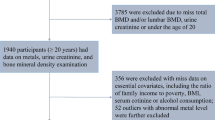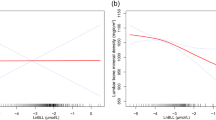Abstract
Several previous studies have found the deleterious effects of cadmium exposure on bone. However, studies on the effects of cadmium exposure on bone mineral density (BMD) in gender- and race-specific groups are still lacking. The aim of this study was to investigate the relationship between cadmium exposure and BMD in adults and the gender and racial differences therein. Weighted multivariate regression, generalized weighted model, and smoothed curve fitting were used to explore the relationship between lumbar BMD with blood cadmium (B-Cd) and urine cadmium (U-Cd) based on data from the National Health and Nutrition Examination Survey (NHANES). In addition, subgroup analyses were further used to investigate the differential associations across gender and race. Of the 4335 adult participants. After adjusting for primary demographic variables, B-Cd [− 0.018 (− 0.028, − 0.008)] and U-Cd [− 0.010 (− 0.020, − 0.001)] were shown to be negatively related to lumbar BMD. In the fully adjusted model, the negative association between B-Cd and lumbar BMD was maintained [− 0.010 (− 0.018, − 0.002)]. In the subgroup analysis stratified by gender and race, this relationship was retained in females and non-Hispanic blacks. Furthermore, these negative associations were most pronounced among non-Hispanic black women [B-Cd and lumbar BMD, − 0.046 (− 0.076, − 0.017); U-Cd and lumbar BMD, -0.034 (− 0.063, − 0.006)]. Our findings suggest that there are significant sex and race differences in the negative association between cadmium exposure and BMD. This negative association was most prominent in non-Hispanic black females.


Similar content being viewed by others
Data Availability
The survey data are publicly available on the internet for data users and researchers throughout the world (www.cdc.gov/nchs/nhanes/).
Abbreviations
- BMD :
-
Bone mineral density
- B-Cd :
-
Blood cadmium
- U-Cd :
-
Urine cadmium
- NHANES :
-
National Health and Nutrition Examination Survey
- NCHS :
-
Health Statistics
- BMI :
-
Body mass index
- ALT :
-
Alanine aminotransferase
- ALP :
-
Alkaline phosphatase
- AST :
-
Alanine transaminase
- PTH :
-
Parathyroid hormone
References
Consensus development conference (1993) diagnosis, prophylaxis, and treatment of osteoporosis. Am J Med 94(6):646–650
Glaser DL, Kaplan FS (1997) Osteoporosis. Definition and clinical presentation. Spine (Phila Pa 1976) 22(24 Suppl):12s–16s
Alejandro P, Constantinescu F (2018) A review of osteoporosis in the older adult: an update. Rheum Dis Clin North Am 44(3):437–451
Xie R, Huang X, Zhang Y, Liu Q, Liu M (2022) High low-density lipoprotein cholesterol levels are associated with osteoporosis among adults 20–59 years of age. Int J Gen Med 15:2261–2270
Xie R, Huang X, Liu Q, Liu M (2022) Positive association between high-density lipoprotein cholesterol and bone mineral density in U.S. adults: the NHANES 2011–2018. J Orthop Surg Res 17(1):92
Xie R, Liu M (2022) Relationship between non-alcoholic fatty liver disease and degree of hepatic steatosis and bone mineral density. Front Endocrinol 13:857110
Ouyang Y, Quan Y, Guo C, Xie S, Liu C, Huang X, Huang X, Chen Y, Xiao X, Ma N et al (2022) Saturation effect of body mass index on bone mineral density in adolescents of different ages: a population-based study. Front Endocrinol (Lausanne) 13:922903
Lu J, Lan J, Li X, Zhu Z (2021) Blood lead and cadmium levels are negatively associated with bone mineral density in young female adults. Arch Public Health 79(1):116
Buha A, Jugdaohsingh R, Matovic V, Bulat Z, Antonijevic B, Kerns JG, Goodship A, Hart A, Powell JJ (2019) Bone mineral health is sensitively related to environmental cadmium exposure- experimental and human data. Environ Res 176:108539
Wang M, Wang X, Liu J, Wang Z, Jin T, Zhu G, Chen X (2021) The association between cadmium exposure and osteoporosis: a longitudinal study and predictive model in a Chinese female population. Front Public Health 9:762475
Satarug S, Garrett SH, Sens MA, Sens DA (2010) Cadmium, environmental exposure, and health outcomes. Environ Health Perspect 118(2):182–190
Snoj Tratnik J, Kocman D, Horvat M, Andersson AM, Juul A, Jacobsen E, Ólafsdóttir K, Klanova J, Andryskova L, Janasik B et al (2022) Cadmium exposure in adults across Europe: results from the HBM4EU aligned studies survey 2014–2020. Int J Hyg Environ Health 246:114050
Thomas LD, Elinder CG, Wolk A, Åkesson A (2014) Dietary cadmium exposure and chronic kidney disease: a population-based prospective cohort study of men and women. Int J Hyg Environ Health 217(7):720–725
Borné Y, Fagerberg B, Persson M, Sallsten G, Forsgard N, Hedblad B, Barregard L, Engström G (2014) Cadmium exposure and incidence of diabetes mellitus–results from the Malmö diet and cancer study. PLoS One 9(11):e112277
Xiao L, Li W, Zhu C, Yang S, Zhou M, Wang B, Wang X, Wang D, Ma J, Zhou Y et al (2021) Cadmium exposure, fasting blood glucose changes, and type 2 diabetes mellitus: a longitudinal prospective study in China. Environ Res 192:110259
Gardner RM, Kippler M, Tofail F, Bottai M, Hamadani J, Grandér M, Nermell B, Palm B, Rasmussen KM, Vahter M (2013) Environmental exposure to metals and children’s growth to age 5 years: a prospective cohort study. Am J Epidemiol 177(12):1356–1367
Mijal RS, Holzman CB (2010) Blood cadmium levels in women of childbearing age vary by race/ethnicity. Environ Res 110(5):505–512
Banjabi AA, Kannan K, Kumosani TA, Yousef JM, Abulnaja KO, Moselhy SS (2021) Association of blood heavy metal levels with osteocalcin abnormality and incidence of osteoporosis in Saudi subjects. Braz J Biol 83:e248828
Kim ES, Shin S, Lee YJ, Ha IH (2021) Association between blood cadmium levels and the risk of osteopenia and osteoporosis in Korean post-menopausal women. Arch Osteoporos 16(1):22
Chen X, Zhu G, Jin T, Gu S (2009) Effects of cadmium on forearm bone density after reduction of exposure for 10 years in a Chinese population. Environ Int 35(8):1164–1168
Zhu G, Wang H, Shi Y, Weng S, Jin T, Kong Q, Nordberg GF (2004) Environmental cadmium exposure and forearm bone density. Biometals 17(5):499–503
Qing Y, Yang J, Chen Y, Shi C, Zhang Q, Ning Z, Yu Y, Li Y (2021) Urinary cadmium in relation to bone damage: cadmium exposure threshold dose and health-based guidance value estimation. Ecotoxicol Environ Saf 226:112824
Pouillot R, Santillana Farakos S, Van Doren JM (2022) Modeling the risk of low bone mass and osteoporosis as a function of urinary cadmium in US adults aged 50–79 years. Environ Res 212(Pt B):113315
Börjesson J, Bellander T, Järup L, Elinder CG, Mattsson S (1997) In vivo analysis of cadmium in battery workers versus measurements of blood, urine, and workplace air. Occup Environ Med 54(6):424–431
Lauwerys R, Roels H, Regniers M, Buchet JP, Bernard A, Goret A (1979) Significance of cadmium concentration in blood and in urine in workers exposed to cadmium. Environ Res 20(2):375–391
Adams SV, Newcomb PA (2014) Cadmium blood and urine concentrations as measures of exposure: NHANES 1999–2010. J Expo Sci Environ Epidemiol 24(2):163–170
Peters JL, Perlstein TS, Perry MJ, McNeely E, Weuve J (2010) Cadmium exposure in association with history of stroke and heart failure. Environ Res 110(2):199–206
Zota AR, Needham BL, Blackburn EH, Lin J, Park SK, Rehkopf DH, Epel ES (2015) Associations of cadmium and lead exposure with leukocyte telomere length: findings from National Health and Nutrition Examination Survey, 1999–2002. Am J Epidemiol 181(2):127–136
Kazantzis G (2004) Cadmium, osteoporosis and calcium metabolism. Biometals 17(5):493–498
Yan J, Huo J, Li R, Jia Z, Song Y, Chen J, Zhang L (2019) Benchmark dose estimation of urinary and blood cadmium as biomarkers of renal dysfunction among 40–75-year-old non-smoking women in rural areas of southwest China. J Appl Toxicol 39(10):1433–1443
Kjellström T (1992) Mechanism and epidemiology of bone effects of cadmium. IARC Sci Publ 118:301–310
Youness ER, Mohammed NA, Morsy FA (2012) Cadmium impact and osteoporosis: mechanism of action. Toxicol Mech Methods 22(7):560–567
Papa V, Bimonte VM, Wannenes F, D’Abusco AS, Fittipaldi S, Scandurra R, Politi L, Crescioli C, Lenzi A, Di Luigi L et al (2015) The endocrine disruptor cadmium alters human osteoblast-like Saos-2 cells homeostasis in vitro by alteration of Wnt/β-catenin pathway and activation of caspases. J Endocrinol Invest 38(12):1345–1356
Brama M, Politi L, Santini P, Migliaccio S, Scandurra R (2012) Cadmium-induced apoptosis and necrosis in human osteoblasts: role of caspases and mitogen-activated protein kinases pathways. J Endocrinol Invest 35(2):198–208
Luo H, Gu R, Ouyang H, Wang L, Shi S, Ji Y, Bao B, Liao G, Xu B (2021) Cadmium exposure induces osteoporosis through cellular senescence, associated with activation of NF-κB pathway and mitochondrial dysfunction. Environ Pollut 290:118043
Xiong Q, Tang P, Gao Y, Zhang L, Ge W (2015) Proteomic analysis of estrogen-mediated signal transduction in osteoclasts formation. Biomed Res Int 2015:596789
Brzóska MM, Moniuszko-Jakoniuk J (2005) Bone metabolism of male rats chronically exposed to cadmium. Toxicol Appl Pharmacol 207(3):195–211
He S, Zhuo L, Cao Y, Liu G, Zhao H, Song R, Liu Z (2020) Effect of cadmium on osteoclast differentiation during bone injury in female mice. Environ Toxicol 35(4):487–494
Author information
Authors and Affiliations
Contributions
YZ and RX designed the research. RX, YL, JW, MX, and CZ collected, analyzed the data, and drafted the manuscript. ML, RX, and YZ revised the manuscript. All authors contributed to the article and approved the submitted version.
Corresponding author
Ethics declarations
Ethics Approval
This is an observational study. The Research Ethics Committee of the institute the senior authors are affiliated has confirmed that no ethical approval is required. Data collection agencies obtained informed consent from all participants included in the study.
Consent for Publication
Not applicable.
Competing Interests
The authors declare no competing interests.
Additional information
Publisher's Note
Springer Nature remains neutral with regard to jurisdictional claims in published maps and institutional affiliations.
Supplementary Information
Below is the link to the electronic supplementary material.
Rights and permissions
Springer Nature or its licensor (e.g. a society or other partner) holds exclusive rights to this article under a publishing agreement with the author(s) or other rightsholder(s); author self-archiving of the accepted manuscript version of this article is solely governed by the terms of such publishing agreement and applicable law.
About this article
Cite this article
Xie, R., Liu, Y., Wang, J. et al. Race and Gender Differences in the Associations Between Cadmium Exposure and Bone Mineral Density in US Adults. Biol Trace Elem Res 201, 4254–4261 (2023). https://doi.org/10.1007/s12011-022-03521-y
Received:
Accepted:
Published:
Issue Date:
DOI: https://doi.org/10.1007/s12011-022-03521-y




